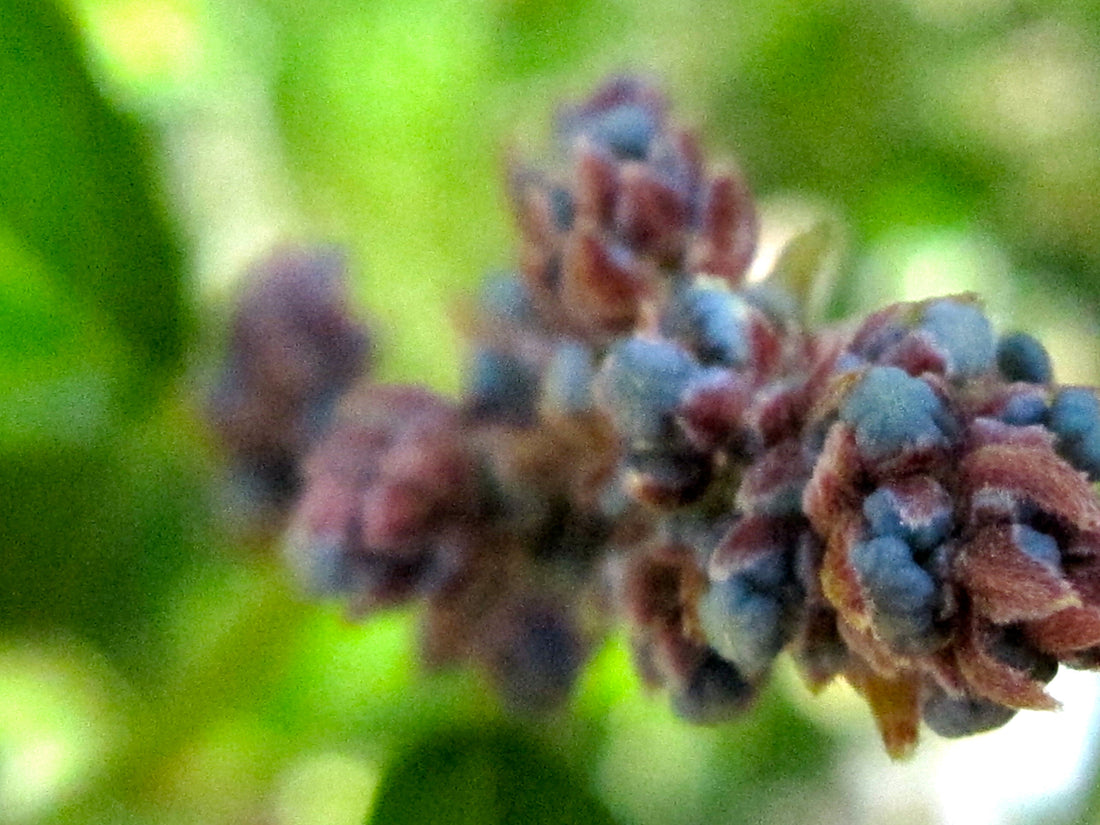
Ceanothus Flower Soap-Scrub: A Single-Ingredient Exfoliating Cleanser
Share
Ceanothus spinosus — Greenbark / Redheart (Flower-Only, Clean Beauty)
Ceanothus spinosus — chaparral native • external use only • single-ingredient cleanser
Experience Ceanothus spinosus (Flower)
Along the coastal chaparral, Greenbark Ceanothus bursts into pale blue-white bloom. Rub the blossoms with a splash of water and they foam on contact — thanks to naturally occurring plant saponins. Finely milled into a silky powder, the flowers become a minimalist soap-scrub: soft lather + feather-light polish, with no added surfactants or fragrance.
Texture & Character
- Lather: quick, soft bloom (flower saponins + water)
- Polish: ultra-fine “grit” for gentle mechanical exfoliation
- Finish: refreshed, not stripped; a clean, smooth feel
- Energetics: gentle, cool-neutral; suitable for most skin when used with a light touch
Uses & Benefits
- Built-in suds: water + flower powder creates a soft, creamy lather.
- Gentle exfoliation: lifts dull surface buildup with minimal pressure.
- Single-ingredient simplicity: just the flower—no essential oil, no added fragrance.
- Sense of place: a California chaparral ritual rooted in local ethnobotany.
Clean Beauty Rationale
- Acid-mantle friendly by design: Traditional bar soaps are often highly alkaline; frequent use of high-pH cleansers can disrupt the skin barrier. We keep this product water-free and single-ingredient so you control dilution and pressure.
- Fragrance-free: No added perfume (a common contact allergen for a portion of the population).
- No plastic microbeads (ever): Our exfoliation is purely botanical. (Plastic microbeads in rinse-off cosmetics are banned in the U.S.)
- No ethoxylated detergents: We avoid SLES/PEG-type surfactants, which can carry trace 1,4-dioxane contamination if not carefully removed during manufacturing.
- Dry formula = minimal preservation needs: With no water in the jar, there’s no traditional water-phase to preserve. (Still keep the product dry and avoid introducing moisture into the container.)
How to Use (Face/Body)
- Dispense: place ½–1 tsp powder in your palm.
- Bloom: add ~½–1 tsp water.
- Lather: rub hands with a light touch until foam forms; avoid the eye area.
- Rinse: rinse thoroughly; follow with your preferred hydrator.
Frequency: 1–3×/week. On sensitive or redness-prone skin, minimize pressure or apply as a brief foam mask with little to no scrubbing.
Chemistry & Research †
The flower lather comes from saponins. Across the Ceanothus genus, aerial parts (flowers/leaves/stems) also report triterpenoid acids (e.g., ceanothenic/alphitolic), sterols (β-sitosterol/stigmasterol), and flavonoids (e.g., kaempferol). This aligns with the gentle cleansing + polished feel observed in use. Direct, species-specific quantification for C. spinosus flowers remains limited; this overview reflects genus-level findings plus local ethnobotany.
Sustainability & Harvesting
- Harvest lightly at peak bloom; dry quickly with shade and airflow to preserve quality.
- Leave ample flowers for pollinators and overall shrub vitality; take only what you need.
- Our harvests are pesticide-free, from wild-grown stands managed for long-term habitat health.
FAQ
Is there any essential oil or added fragrance?
No. This is a single-ingredient flower powder—no essential oil and no added fragrance.
Can it cause broken capillaries?
There’s no specific evidence that C. spinosus flower powder causes telangiectasia. As with any mechanical exfoliant, vigorous pressure on delicate or flush-prone areas may aggravate redness. Use a feather-light touch or limit to a brief foam application on those zones.
Is it suitable for sensitive skin?
Often yes—when used gently and not too often. Always patch test (inner arm or behind ear) before first full use, and discontinue if irritation occurs.
How should I store it?
Keep the jar tightly closed, away from humidity and direct sunlight. Because it’s a pure botanical, color and texture may vary slightly by harvest.
Disclaimer: Educational content only; not medical advice. External flower use is based on ethnobotany and genus-level chemistry reports. No clinical claims are made. Patch test before use, avoid eye area, and discontinue if irritation occurs.
† Research note: modern, species-specific analyses of C. spinosus flowers are limited; related Ceanothus aerial-part chemistry informs this overview.
